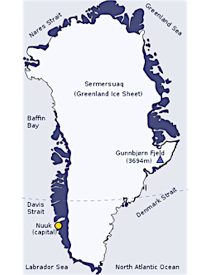
Publishers of the Times World Atlas are under fire for exaggerating ice loss in Greenland and are “urgently reviewing” their newest map of that country. HarperCollins claims the latest edition of its atlas, published September 15, depicts the world “at its most fragile,” but scientists say it shows a dream world. One expert told Reuters the atlas suggests Greenland’s massive ice sheets are shrinking at a rate that “could easily be 20 times too fast and might well be 50 times too fast.”
HarperCollins admitted it erased 15 percent of Greenland’s ice cover from its previous 2007 atlas, an amount Elizabeth Morris of Cambridge University’s Scott Polar Research Institute said “would lead to a sea level rise of 1 metre,” according to Varsity. She and six colleagues wrote a letter to the publisher calling the mistake “implausible” and “stupid.” Glaciologist Poul Christofferson also signed the letter and told Reuters that “a sizable portion of the area mapped as ice-free in the Atlas is clearly still ice-covered.”
Originally, HarperCollins described the thaw, equal in size to the United Kingdom and Ireland combined, as “concrete evidence of how climate change is altering the face of the planet forever — and doing so at an alarming and accelerating rate.” Now that the truth is out, did the publisher apologize? Hardly! The web site offers this vapid excuse: “On reflection and in discussion with the scientific community, the current map does not make the explanation of this topic as clear as it should be.” The publisher promises an insert for the atlas, not to correct the mistake, but to “give an explanation of the situation and how we have mapped it.” It audaciously declares the error as fortunate if it “encourages scientists to come together and clarify some of the confusion about our climate and how it is changing.”
HarperCollins also claimed the University of Colorado’s National Snow and Ice Data Center (NSIDC) supplied research for the map that spawned this storm of debate. The Guardian reports NSIDC blames Times Atlas editors for misinterpreting their data. “NSIDC has never released a specific number for Greenland data sets and imagery,” said spokesman Dr. Julienne Stroeve. “While it is possible that the Times Atlas obtained data from NSIDC, they may have made their own interpretation of the data, independent of advice of NSIDC.” Stroeve declared the map paints an excessively unrealistic picture.
Ironically, about the same time the new World Atlas was unveiled, NSIDC Director Mark Serreze announced arctic sea ice is witnessing a slight increase, 6.4 percent higher this year than its record low set in 2007. NSIDC bases its data on satellite observations that became available a mere three decades ago. The baseline is therefore made up of 22 seasons, from 1979 through 2000, which amounts to the blink of an eye in terms of cyclical climate variations. The 2007 record low rated 38 percent below that baseline. But is it a fair comparison when melting glaciers are uncovering tree stumps and abandoned Viking settlements on Greenland’s now-frozen tundra? Since satellite data is not available from the 10th century on, is 2007’s ice cover really an anomaly?
Greenland’s farmers are certainly enjoying their global warming boon. Until recently, the only vegetables they could grow were potatoes, but now locally grown cauliflower, broccoli, cabbage and even strawberries are lining the shelves of neighborhood supermarkets. Potato harvests are booming. In areas formerly weather-restricted to sheep and reindeer herds, farmers have established successful cattle and dairy operations. The Wall Street Journal reported one rancher described his experience as a genesis. “We have so many cold places in Greenland, and a lot of it is covered with ice,” said Stefan Magnusson. “So we are grateful for those two extra degrees we get.”
Melting glaciers mean more grazing land for herds, fatter animals for slaughter, more cultivatable land and longer growing seasons. Greenland’s farmland has increased from 620 acres in 1980 to more than 2,500. The country’s fishing industry is booming, too. Magnusson said he planned to harness the melting glacier water pouring into a nearby river for hydroelectricity.
Related stories:




